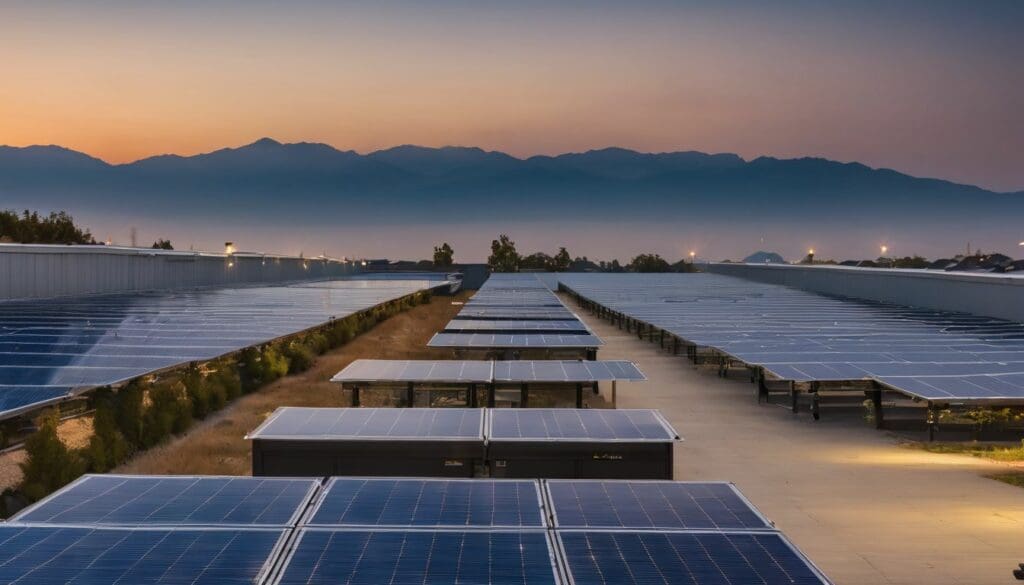Are you feeling the pinch with energy bills on the up and up? You’re certainly not alone in seeking out more sustainable – not to mention wallet-friendly – alternatives. Since 2009, solar energy has become a staggering 89% less expensive, putting renewable energy solutions well within our grasp.
This article aims to demystify the often complex realm of domestic renewables, helping you to make an informed choice about eco-friendly power that’s as sensible as it is straightforward.
So, let’s shed some light on how we can all contribute to a brighter and greener tomorrow!
Key Takeaways
- Solar energy costs have dropped by 89% since 2009, making it an increasingly affordable option for home renewable energy.
- Different types of renewable energy for homes include solar power, wind energy, biomass systems, hydroelectric systems, and air source heat pumps.
- Evaluating your current energy consumption is vital to determining the most suitable renewable technology for your home’s needs.
- Local policies and incentives can significantly offset initial costs of installing renewable systems; researching these is key to well-informed decision-making.
- Connecting your renewable system to the grid allows you to sell excess electricity back, potentially earning financial credit while promoting sustainability.
Understanding Renewable Energy for Your Home
Renewable energy is a sustainable and environmentally friendly source of power that can be used in your home. It’s important to consider renewable energy options for various benefits such as reducing carbon footprint, lowering utility bills and increasing energy independence.
What is renewable energy?
Renewable energy comes from sources that nature keeps replenishing, such as the sun’s warmth, wind blowing across the land, flowing water in rivers, and plants growing in fields. Unlike fossil fuels like coal and oil that take millions of years to form and deplete over time, renewable sources are constantly available or can quickly renew themselves.
We harness these natural forces to create clean energy without emitting harmful pollutants into our environment.
Using solar panels on our rooftops converts sunshine directly into electricity for our homes. Wind turbines capture the power of moving air to generate energy. We also tap into other forms like geothermal heat from beneath the earth’s surface or biomass from organic materials to sustainably meet our daily needs.
By choosing renewable energy products for our homes, we’re making a conscious decision to support sustainable living and help preserve the planet for future generations.
Importance of considering renewable energy for your home
Considering renewable energy for your home is crucial for reducing reliance on non-renewable resources and decreasing carbon emissions. By embracing solar power, wind energy, or other renewable options, homeowners can make a significant impact on the environment while cutting down long-term utility costs.
Embracing eco-friendly products, such as rooftop solar panels and energy-efficient appliances, not only benefits the planet but also enhances property value and contributes to sustainable living practices.
Making the switch to renewable energy sources reflects a commitment to environmental conservation and responsible resource management. It empowers individuals to be part of the solution in addressing climate change by minimising their carbon footprint while enjoying more control over their household energy consumption.
Types of Renewable Energy Sources
When considering renewable energy for your home, it is important to explore various options such as solar power, wind energy, biomass systems, and hydroelectric systems. Each type offers unique benefits and considerations that are worth exploring in more detail.
Solar power
Solar power is a popular renewable energy source for homes. It involves installing solar panels on the roof to capture sunlight and convert it into electricity. Solar power can significantly reduce your reliance on traditional grid electricity, leading to long-term cost savings and reduced environmental impact.
Additionally, investing in solar power promotes sustainability and reduces greenhouse gas emissions, making it an eco-friendly choice for environmentally conscious individuals looking to support conservation efforts.
When considering residential renewable energy options like solar power, it’s important to evaluate your property’s sun exposure and potential space for panel installation. Assessing costs and benefits will help determine whether solar power is a suitable choice for your home, while exploring local policies and incentives can provide aid in financing such an energysaving upgrade.
Solar heating
Solar heating systems use the sun’s energy to provide hot water and space heating for your home. These systems typically consist of solar panels, a heat transfer system, and a storage tank.
Solar thermal collectors on the roof absorb sunlight and convert it into usable heat, which is then transferred to water or an anti-freeze solution that flows through pipes to provide warmth or hot water when needed.
This eco-friendly technology reduces your reliance on traditional energy sources, helping you cut down on utility bills while reducing your carbon footprint.
When considering solar heating for your home, assess whether your location receives enough sunlight to make this technology viable. It’s also important to ensure that there’s adequate space for installation and that local policies and incentives support the implementation of such renewable energy solutions.
Air source heat pumps
Air source heat pumps are an effective way to harness renewable energy for heating and cooling your home. They work by extracting heat from the outside air, even in cold weather, and transferring it inside.
This process is incredibly energy-efficient and can provide substantial cost savings on your heating and cooling bills.
With their ability to operate in various climates, air source heat pumps offer a reliable solution for environmentally conscious individuals seeking green energy options. By incorporating this technology into your home, you can significantly reduce your carbon footprint while enjoying comfortable indoor temperatures throughout the year.
Wind energy
Wind energy is a clean and renewable source of power that harnesses the natural force of wind to generate electricity. Wind turbines, usually placed in open areas or offshore, capture the kinetic energy of the wind and convert it into electrical energy.
This eco-friendly method produces no greenhouse gas emissions, making it an excellent choice for reducing your carbon footprint and supporting sustainable living.
By investing in wind energy for your home, you can take advantage of a constant and readily available resource while contributing to cleaner air and a healthier environment. Plus, with advancements in technology, modern wind turbines are designed to be more efficient and quieter than ever before.
Biomass systems
Biomass systems use organic materials, such as wood chips, agricultural residues, and even certain types of waste to generate heat or electricity. The process involves burning the biomass to produce energy.
This renewable energy source is carbon neutral since the carbon dioxide released during combustion is offset by the CO2 absorbed by the plants during growth. Biomass systems can provide a sustainable alternative for heating and powering your home while reducing reliance on fossil fuels and lowering greenhouse gas emissions.
Using biomass energy in your home not only reduces your environmental impact but also supports local economies by creating demand for locally sourced organic materials. These systems offer an eco-friendly way to meet your household’s heating and power needs without contributing to climate change or air pollution.
Hydroelectric systems
When considering renewable energy for your home, hydroelectric systems offer a reliable and consistent source of power. By harnessing the natural flow of water, these systems generate electricity without emitting greenhouse gases or relying on finite resources.
Installing a micro-hydro system can provide sustainable energy for homes located near streams or rivers, making it an ideal option for environmentally conscious individuals seeking to reduce their carbon footprint and support conservation efforts.
With proper planning and installation, hydroelectric systems can contribute to a more eco-friendly household while also providing long-term cost savings.
Choosing the Right Renewable Energy Technology
When choosing the right renewable energy technology for your home, it’s important to evaluate your energy consumption, conduct a property inspection, familiarise yourself with local policies and incentives, and explore financing options.
These steps will help you make an informed decision on the best renewable energy system for your home.
Evaluating your energy consumption
To ensure the right renewable energy technology for your home, we need to first evaluate your energy consumption. This step is crucial in determining the most suitable renewable energy source and system size for your needs. Here are steps to consider:
- Analyse past utility bills and assess your historical energy usage patterns.
- Identify areas of high energy consumption within your home such as heating, cooling, lighting, and appliances.
- Conduct an energy audit to pinpoint areas for potential savings through energy-efficient upgrades.
- Calculate the total energy demand required for your household based on current usage and potential improvements.
- Consider lifestyle changes that could lead to reduced energy consumption before investing in a renewable energy system.
Property inspection
When considering renewable energy for your home, remember that a property inspection is crucial. Here are the essential steps to consider during a property inspection:
- Evaluate the available space on your property to determine the most suitable renewable energy technology.
- Assess the orientation and layout of your home to optimise solar panel or wind turbine placement.
- Identify any potential shading or obstructions that could affect the efficiency of renewable energy systems.
- Check the structural integrity and load – bearing capacity of your property to support the installation of renewable energy products.
- Consider any planning permissions or building regulations that may apply to the installation of renewable energy systems in your area.
- Analyse the existing energy infrastructure on your property to ensure compatibility with chosen renewable energy technologies.
- Consult with professional assessors or installers to gain expert insight into the specific requirements for integrating renewable energy systems into your home.
Familiarising with local policies and incentives
Researching local policies and incentives is crucial when considering renewable energy for your home. It’s important to understand any available rebates, tax credits, or grants that could help offset the initial costs of installing renewable energy systems.
Additionally, being aware of zoning regulations and building codes can prevent legal issues and streamline the installation process. By familiarising ourselves with these aspects, we can make more informed decisions about which renewable energy technologies are viable for our homes while maximising potential benefits.
Understanding the local landscape helps us take full advantage of opportunities within our area. We can seek out support from authorities and utilise financial incentives to invest in sustainable energy solutions – contributing to a greener future while also making practical financial decisions for our households.
Exploring financing options
When researching financing options, consider government incentives and rebates that may be available for renewable energy installations. Research potential tax credits and grants that can help offset the installation costs, making it more affordable to invest in renewable energy products for your home.
It’s essential to explore different financing options such as loans or leasing arrangements from reputable providers specialising in renewable energy solutions. By investigating these opportunities, you can find a financial path that aligns with your eco-friendly priorities while supporting conservation efforts.
After exploring financing options, the next step is planning for a home renewable energy system by assessing costs and benefits and incorporating energy efficiency into your household.
Planning for a Home Renewable Energy System
When planning for a home renewable energy system, it’s important to incorporate energy efficiency and assess the costs and benefits. Connecting to the grid and selling excess energy can also be part of your plan.
Incorporating energy efficiency
When incorporating energy efficiency into your home renewable energy system, start by assessing your current energy consumption. This will help you identify areas where you can make energysaving upgrades.
Look for energyefficient appliances and ecofriendly products that align with your goal of reducing environmental impact. By integrating these changes, you can create a more sustainable and cost-effective home environment while supporting conservation efforts.
To ensure an effective transition to renewable energy, consider conducting a property inspection to determine the best placement for alternative energy sources like solar panels or air source heat pumps.
Assessing costs and benefits
As environmentally conscious individuals, we appreciate the significance of evaluating the financial implications and ecological advantages of introducing renewable energy systems into our homes. The table below summarises key considerations in assessing the costs and benefits of renewable energy investments:
| Cost Factors | Benefit Factors |
|---|---|
| Initial investment in renewable technology | Reduction in electricity bills over time |
| Maintenance expenses | Enhanced property value |
| Potential need for additional infrastructure | Eligibility for government incentives and rebates |
| Cost of financing the renewable system | Contribution to reducing carbon footprint |
| Replacement costs for parts or the whole system | Increased energy independence |
Careful planning and consideration ensure we make informed decisions that align with our commitment to environmental conservation.
Connecting to the grid and selling excess energy
After installing renewable energy systems in our home, we can connect to the grid and sell excess energy. This involves working with local utility companies to establish a connection for feeding surplus electricity back into the power grid.
We may need a special meter that tracks the amount of electricity we generate and contribute to the grid. Selling excess energy not only benefits us financially but also contributes to overall sustainability by providing clean, renewable power to others.
Connecting our home renewable energy system to the grid allows us to offset our own electricity usage and potentially earn credit from utility companies through net metering. By selling surplus energy back to the grid, we play an active role in promoting sustainable energy practices within our community while also reducing our reliance on non-renewable fuel sources.
FAQs about Choosing Renewable Energy for Your Home
Curious about the costs and benefits of home renewable energy systems? Wondering how much space you’ll need for installation or how to connect to the grid? Find answers to these common questions here.
Comparing costs and benefits
When comparing costs and benefits of renewable energy systems, it’s important to consider long-term savings alongside initial investment. Assessing the potential reduction in utility bills over time against the upfront cost is vital. Additionally, exploring available incentives and financing options can make adopting renewable energy more financially feasible.
Understanding the economic advantages and environmental impact of different renewable energy technologies will help us make informed decisions for our homes. Evaluating the long-term financial gains along with positive environmental outcomes will guide us towards choosing the most suitable renewable energy system for our individual needs.
Moving forward, let’s delve into understanding space requirements for installation.
Space needed for installation
When considering the space needed for installation of renewable energy products, it’s essential to assess the physical area required for different technologies. Solar panels typically need unobstructed access to sunlight and sufficient roof or ground space.
Similarly, wind turbines demand open areas with minimal obstructions to harness wind power effectively. Air source heat pumps may require outdoor space near your home for installation.
Understanding the specific spatial requirements of each technology is crucial in determining which renewable energy product is suitable for your property.
Geothermal power systems necessitate a significant amount of underground space for loop placement, making them more feasible in larger properties with ample land availability. Biomass systems also need enough indoor or outdoor room for fuel storage and boiler installation.
Connecting to the grid
When connecting to the grid, we must ensure that our renewable energy system meets the local regulations and standards. This process typically involves securing a connection agreement with the utility company.
It’s important to consult with them early in your planning process to understand their requirements and any potential costs involved.
We need to install a bi-directional electricity meter which allows us to measure both the electricity we consume from the grid and the excess electricity we export. This enables us to benefit from feed-in tariffs or net metering schemes, where applicable, allowing us to sell any surplus energy back into the grid.
Conclusion
Evaluate your energy consumption to find the right renewable energy technology for your home. Consider local policies and incentives that could support your decision. Familiarise yourself with financing options to make the transition easier.
Incorporate energy efficiency into your planning for a more sustainable solution. Connect to the grid and sell excess energy generated by your system.
FAQs
1. What should I consider when choosing renewable energy products for my home?
Think about which renewable energy sources, like solar panels or geothermal power systems, are most effective in your area and match your energy needs.
2. How does geothermal power work for homes?
Geothermal power systems use the earth’s steady underground temperature to heat or cool your home, offering a constant and eco-friendly energy option.
3. Are there benefits to using renewable energy products at home?
Yes! Renewable energy products can lower your electricity bills, reduce carbon emissions, and potentially increase the value of your property.
4. Can any home install a geothermal power system?
Most homes can have a geothermal system installed; however, you’ll need enough space for the ground loop system and professional advice on proper installation.





